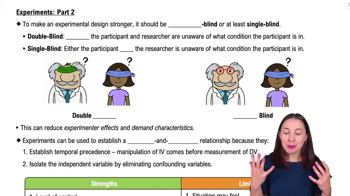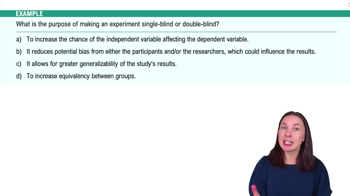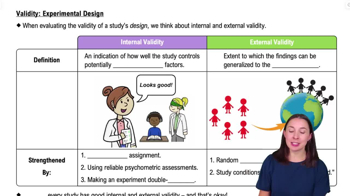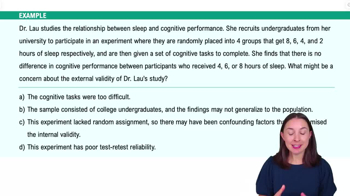Table of contents
- 1. Introduction to Psychology1h 43m
- 2. Psychology Research2h 20m
- 3. Biological Psychology2h 41m
- 4. Sensation and Perception28m
- 5. Consciousness and Sleep32m
- 6. Learning41m
- 7. Memory34m
- 8. Cognition37m
- 9. Emotion and Motivation35m
- 10. Developmental Psychology33m
- 11. Personality48m
- 12. Social Psychology41m
- 13. Stress and Health41m
- 14. Psychological Disorders44m
- 15. Treatment47m
2. Psychology Research
Intro to Research Methods
Struggling with Psychology?
Join thousands of students who trust us to help them ace their exams!Watch the first videoMultiple Choice
The tendency of interviewers to allow the positive attributes of a client to influence how they view the client's behavior is called
A
the butterfly effect.
B
the halo effect.
C
projection.
D
the impression effect.
 Verified step by step guidance
Verified step by step guidance1
Understand the concept of the 'halo effect': It is a cognitive bias where the perception of one positive trait (such as attractiveness or intelligence) influences the perception of other traits.
Differentiate the 'halo effect' from other terms: The 'butterfly effect' refers to the idea that small changes can have large effects, 'projection' is a defense mechanism where individuals attribute their own thoughts to others, and the 'impression effect' is not a recognized psychological term.
Identify the context: The problem describes a situation where positive attributes influence the perception of behavior, which aligns with the definition of the 'halo effect'.
Eliminate incorrect options: Based on the definitions, eliminate 'the butterfly effect', 'projection', and 'the impression effect' as they do not fit the described scenario.
Conclude that the correct term for the described tendency is the 'halo effect', as it specifically addresses how positive attributes can influence overall perception.

 1:46m
1:46mWatch next
Master Roadmap of the Lesson with a bite sized video explanation from Hannah Gordils
Start learningRelated Videos
Related Practice



























































